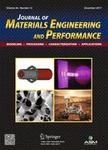版权所有:内蒙古大学图书馆 技术提供:维普资讯• 智图
内蒙古自治区呼和浩特市赛罕区大学西街235号 邮编: 010021

作者机构:Kunming Univ Sci & Technol Fac Mat Sci & Engn Kunming 650093 Peoples R China Kunming Univ Sci & Technol City Coll Kunming 650051 Peoples R China Univ Sci & Technol Beijing Inst Adv Mat & Technol Beijing 100083 Peoples R China Kunming Univ Sci & Technol Res Ctr Anal & Measurement Kunming 650093 Peoples R China Yunnan Titanium Ind Co Chuxiong 651200 Peoples R China
出 版 物:《JOURNAL OF MATERIALS ENGINEERING AND PERFORMANCE》 (J Mater Eng Perform)
年 卷 期:2025年第34卷第9期
页 面:7584-7591页
核心收录:
学科分类:08[工学] 0805[工学-材料科学与工程(可授工学、理学学位)]
基 金:Key Research and Development Project of Yunnan Province and International Science and Technology Cooperation Project [202103AF140004] Technology talent and platform plan [202305AQ350001] Key research and development project of Yunnan Province [202203AM140010] National and Local Joint Engineering Laboratory of Advanced Metal Solidification Forming and Equipment Technology, and Joint Laboratory for Key Technologies of Titanium Forming, Kunming University of Science and Technology, Kunming, China
主 题:8YSZ 3D printing agglomerant mechanical properties printing parameters
摘 要:In this study, the authors refined and molded 8 wt.% yttrium-stabilized zirconia (8YSZ) ceramic powders by using extrusion 3D printing to obtain green bodies. The green bodies were then subjected to degreasing and sintering to obtain the final parts. It used two printing nozzles, with diameters of 0.8 and 0.6 mm, for 3D molding, and examined the macroscopic and microscopic characteristics of the green, brown, and sintered parts. The parts printed by using both nozzles exhibited smooth surfaces and satisfactory layer-to-layer bonding. However, there were differences in the densities of the sintered parts obtained by using the two nozzles. The sintered part printed by using the nozzle with a diameter of 0.6 mm had a higher density of 5.37 g/cm3, while that printed by using the nozzle with a diameter of 0.8 mm had a density of 4.59 g/cm3. The bending strengths of the sintered bodies manufactured by using nozzles with diameters of 0.8 and 0.6 mm were 114.4 and 261.9 MPa, respectively.